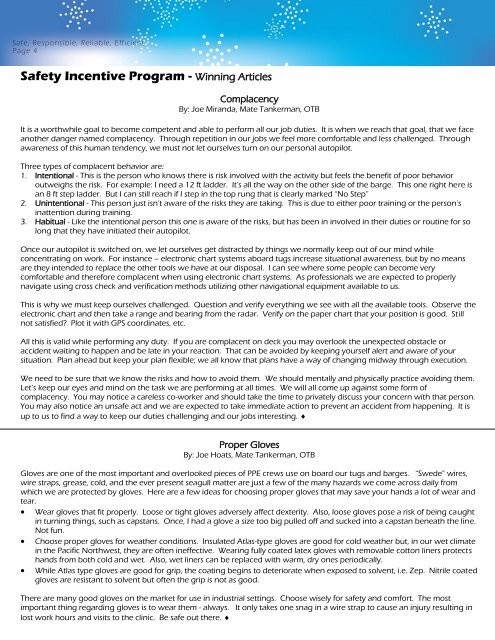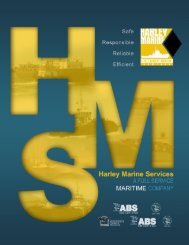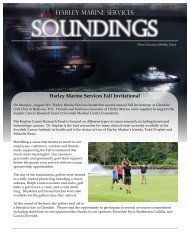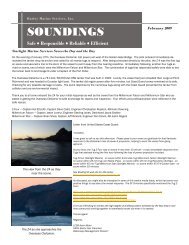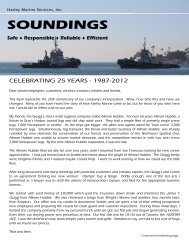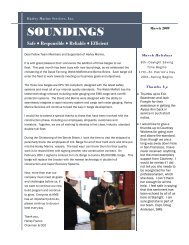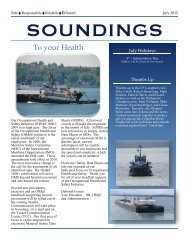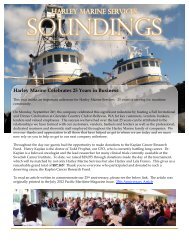December - Harley Marine Services, Inc.
December - Harley Marine Services, Inc.
December - Harley Marine Services, Inc.
Create successful ePaper yourself
Turn your PDF publications into a flip-book with our unique Google optimized e-Paper software.
Safe, Responsible, Reliable, Efficient<br />
Page 4<br />
Safety <strong>Inc</strong>entive Program - Winning Articles<br />
Complacency<br />
By: Joe Miranda, Mate Tankerman, OTB<br />
It is a worthwhile goal to become competent and able to perform all our job duties. It is when we reach that goal, that we face<br />
another danger named complacency. Through repetition in our jobs we feel more comfortable and less challenged. Through<br />
awareness of this human tendency, we must not let ourselves turn on our personal autopilot.<br />
Three types of complacent behavior are:<br />
1. Intentional - This is the person who knows there is risk involved with the activity but feels the benefit of poor behavior<br />
outweighs the risk. For example: I need a 12 ft ladder. It’s all the way on the other side of the barge. This one right here is<br />
an 8 ft step ladder. But I can still reach if I step in the top rung that is clearly marked “No Step”<br />
2. Unintentional - This person just isn’t aware of the risks they are taking. This is due to either poor training or the person’s<br />
inattention during training.<br />
3. Habitual - Like the intentional person this one is aware of the risks, but has been in involved in their duties or routine for so<br />
long that they have initiated their autopilot.<br />
Once our autopilot is switched on, we let ourselves get distracted by things we normally keep out of our mind while<br />
concentrating on work. For instance – electronic chart systems aboard tugs increase situational awareness, but by no means<br />
are they intended to replace the other tools we have at our disposal. I can see where some people can become very<br />
comfortable and therefore complacent when using electronic chart systems. As professionals we are expected to properly<br />
navigate using cross check and verification methods utilizing other navigational equipment available to us.<br />
This is why we must keep ourselves challenged. Question and verify everything we see with all the available tools. Observe the<br />
electronic chart and then take a range and bearing from the radar. Verify on the paper chart that your position is good. Still<br />
not satisfied? Plot it with GPS coordinates, etc.<br />
All this is valid while performing any duty. If you are complacent on deck you may overlook the unexpected obstacle or<br />
accident waiting to happen and be late in your reaction. That can be avoided by keeping yourself alert and aware of your<br />
situation. Plan ahead but keep your plan flexible; we all know that plans have a way of changing midway through execution.<br />
We need to be sure that we know the risks and how to avoid them. We should mentally and physically practice avoiding them.<br />
Let’s keep our eyes and mind on the task we are performing at all times. We will all come up against some form of<br />
complacency. You may notice a careless co-worker and should take the time to privately discuss your concern with that person.<br />
You may also notice an unsafe act and we are expected to take immediate action to prevent an accident from happening. It is<br />
up to us to find a way to keep our duties challenging and our jobs interesting. <br />
Proper Gloves<br />
By: Joe Hoats, Mate Tankerman, OTB<br />
Gloves are one of the most important and overlooked pieces of PPE crews use on board our tugs and barges. “Swede” wires,<br />
wire straps, grease, cold, and the ever present seagull matter are just a few of the many hazards we come across daily from<br />
which we are protected by gloves. Here are a few ideas for choosing proper gloves that may save your hands a lot of wear and<br />
tear.<br />
Wear gloves that fit properly. Loose or tight gloves adversely affect dexterity. Also, loose gloves pose a risk of being caught<br />
in turning things, such as capstans. Once, I had a glove a size too big pulled off and sucked into a capstan beneath the line.<br />
Not fun.<br />
Choose proper gloves for weather conditions. Insulated Atlas-type gloves are good for cold weather but, in our wet climate<br />
in the Pacific Northwest, they are often ineffective. Wearing fully coated latex gloves with removable cotton liners protects<br />
hands from both cold and wet. Also, wet liners can be replaced with warm, dry ones periodically.<br />
While Atlas type gloves are good for grip, the coating begins to deteriorate when exposed to solvent, i.e. Zep. Nitrile coated<br />
gloves are resistant to solvent but often the grip is not as good.<br />
There are many good gloves on the market for use in industrial settings. Choose wisely for safety and comfort. The most<br />
important thing regarding gloves is to wear them - always. It only takes one snag in a wire strap to cause an injury resulting in<br />
lost work hours and visits to the clinic. Be safe out there.


